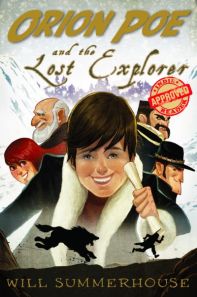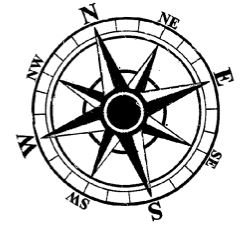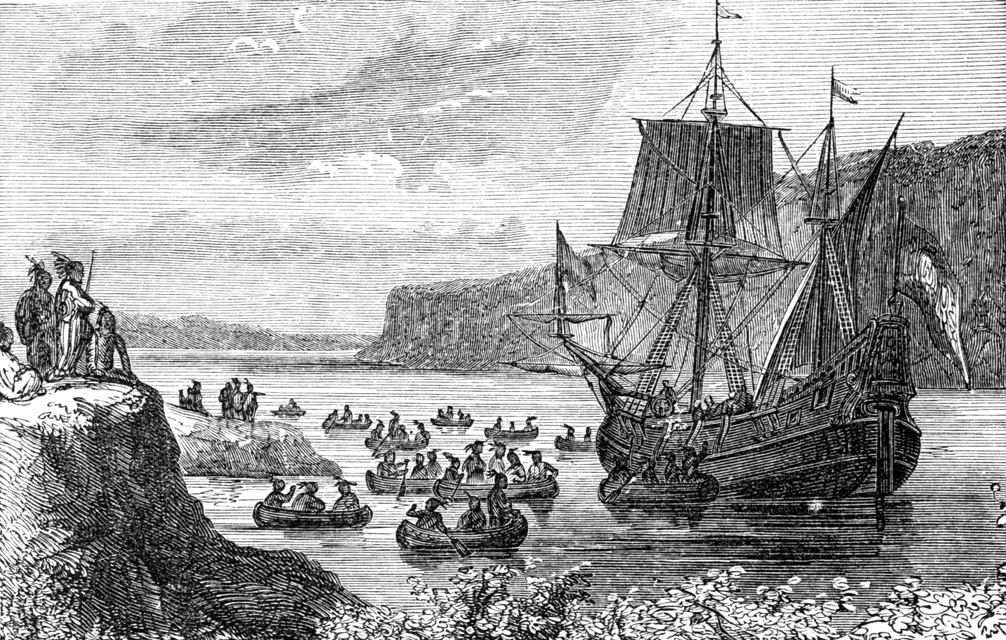 .
.
Orion Poe and the Lost Explorer 
by William Summerhouse
Shake-A-Leg Press 9/14/2014
9780-9860614-0-0
Age 8 to 12 284 pages
.
“Eleven-year-old Orion Poe lives with his stodgy grandfather in eastern Maine, where nothing exciting ever happens. But then a series of strange events draws him into the mystery of the lost explorer and Orion is swept up in a whirlwind of adventure that takes him to the top of the world. To survive he must outwit a scheming treasure hunter, team up with a gang of flimps, and take on a tyrant with an anger management problem. Can Orion solve the mystery and get back home alive? And just what are flimps?”
Opening
“If you read what Mr. Lumpkin wrote in the newspaper about my adventure at the top of the world, you only got half the story.”
The Story
Orion Poe finds a man thrown to the shores of Maine by a nor’easter who turns out to have been running from New Britain, a community at the top of the world. He leaves Orion with a map dated 1847 and written by John Franklin, an explorer looking for the Northwest Passage but disappeared with over 130 men and 2 tall ships. Franklin and his crew were never found.
A John Franklin is the governor of New Britain and a tyrant bent on total control of the inhabitants. He comes searching for the man who Orion found, murders him, and then ransacks Orion’s home looking for the knapsack Orion now has. After taking the map to a professor, the professor and Orion take off on an adventure to find the reason the man washed up on a Maine shore, what he was running from, but mostly, was the map pointing to the lost whereabouts of Franklin and his crew?

Review
Based on the real John Franklin and crew who disappeared and never heard from again, Orion Poe and the Lot Explorer crashes history with adventure in a story difficult to put down. At first, the tall ship looking for the washed up man seemed to be a ghost ship, and it was in its own way, but also a real ship from the 1800’s traveling the current seas. Once at the top of the Canadian Arctic, time stopped for Franklin and his crew and he wanted no one to find out. This once amicable group now lived in tyranny and fear. With the professor and Orion making their way up to the arctic, Franklin’s fears become a reality.
I liked the high seas fighting that occurs and that the real travel times are observed. Orion doesn’t make it to New Britain over night but must face the rough unforgiving sea first. Once there, Orion spends time in the new city and we learn how they could pull off living in such an extreme environment and what year they believe it is: 2013 or 1847. There is also a darker side to this community where the entire group of cast offs are placed. Here a group of courageous kids is quietly fighting the tyranny of New Britain. This side story become important and is some of the best writing.
The edition I received has the author name of William Fourth. I am not sure why this was changed or when, but the real author name is William Summerhouse and many of the books list him as the author. I’m curious as to the change. Throughout the writing is crisp and clean. While reading, it felt like I was right there alongside Orion. Orion Poe and the Lost Explorer, book 1 in the Orion Poe Adventure Series, is Summerhouses debut and it will be rather difficult for him to exceed the story of Orion. Wonderful first start by a promising young writer. Good fun for kids who love fantasy, historical fiction, and most importantly, the mash up of the two genres.
ORION POE AND THE LOST EXPLORER. Text copyright © 2013 by William Summerhouse. Book copyright © 2013 by Shake-A-Leg Press.
Buy Orion Poe and the Lost Explorer at Amazon —B&N—your local bookstore.
—B&N—your local bookstore.
Learn more about Orion Poe and the Lost Explorer HERE.
Book Giveaway! Enter to win HERE.
Meet the author, William Summerhouse, at his website: http://www.willsummerhouse.com/
.
.

Filed under:
6 Stars TOP BOOK,
Books for Boys,
Children's Books,
Debut Author,
Historical Fiction,
Library Donated Books,
Middle Grade,
Series,
Top 10 of 2014 Tagged:
1847,
Arctic,
children's book reviews,
exploer John Franklin,
Northwest Passage,
Shake-a-Leg Press,
William Fourth,
William Summerhouse 







By Roger M. McCoy
Henry Hudson envisioned that he would be the first explorer to find the elusive western passage through North America to the Orient. He persisted in this westward looking vision although his financier, the Dutch East India Company, insisted that he search eastward through the ice-bound sea north of Russia. Hudson had previously tried this northeastern route as well as a northerly route directly over the North Pole. Both had failed due to impassable ice.
On 25 March 1609, Hudson, an Englishman under contract with the Dutch, set sail in the Halve Maen (Half Moon). The Dutch specified that he should not attempt a west route even if the eastern route proved impossible, but Hudson had no interest in another failure. Therefore it is not surprising that he soon found a good reason to end this effort, using the weather as the excuse. As he sailed along the west coast of Norway, the ship encountered severe storms with gale force winds, but examination of the logs also shows much fair weather, raising some doubt that weather actually forced him back. Rather than return to Amsterdam as instructed, Hudson turned west and later anchored in a bay on the coast of Nova Scotia.
On the third of September Hudson sighted an opening to a bay, which appeared to be the mouth of a large river. The next morning they entered what came to be known as New York Bay and dropped anchor. Soon “people of the country” came to the ship carrying trade goods and seemed glad to see the Europeans. They traded green tobacco, deer skins, and maize for knives and beads. He reported that the native people wore skins of foxes and other animals, and were “very civil.” Hudson also noted that the people had copper tobacco pipes, and he inferred that copper naturally existed in the area. Over the next two days other trading sessions took place. Hudson recorded the Indian name for a large island in the river as Manna-Hata.
On the sixth of September five crewmen were determining water depths by boat when they were attacked by natives in two canoes, and one of the crewmen, John Colman, was killed by an arrow in the neck. When Indians came again with their trade goods, the ship’s crew captured two of them briefly, but set one free while the other jumped overboard. No more trading took place under these tense conditions.
Hudson weighed anchor on 13 September 1609 and began his exploration up the great river that still bears his name. He hoped this river might be a connection to the Orient. As the Halve Maen sailed up the river, Hudson wrote in his log, “It is as pleasant a land as one need tread upon; very abundant in all kinds of timber suitable for ship building and for making large casks or vats.” Sixty miles up the river they reported seeing many salmon. “Our boat went out and caught a great many very good fish.” Indians came to the ship and traded corn, pumpkins, and tobacco for what Hudson considered mere trifles, not knowing that the Indians saw these “trifles” as valuable for commerce among themselves.
On the twenty-second of September they found the river too shallow to continue farther upstream, and in the vicinity of present day Albany they turned the ship for a return to the sea. The ship’s log ends during the return crossing with a puzzling gap from the fifth of October to the seventh of November, when the Halve Maen docked in Dartmouth, England. There Hudson was detained by the Crown to prevent him from sailing again for the Dutch. After months of delay the Dutch portion of the crew continued to Amsterdam.
Henry Hudson failed in his quest for a passage through North America, as did many others. This third voyage, however, succeeded by claiming much of present day New York and parts of surrounding states for the Dutch, who began to settle the areas around New York Bay. The Dutch managed to hold their claim until 1674 when the land was ceded to the British.
Why did Hudson stop in England rather than Holland? There is no clear answer; perhaps he was avoiding repercussions for blatantly disregarding instructions, or perhaps the English component of the crew forced him to stop in England. The gap in the log might have shed light on this question. There are several known instances of dissent and mutiny among Hudson’s crews over his four voyages, the last one leading to his abandonment and disappearance with eight others on the shore of Hudson Bay in June 1611. Hudson’s greatest weakness was a leadership style that provoked his crews to mutiny, and in the end this weakness defeated his ambition for exploration.
Roger M. McCoy is Professor Emeritus of Geography at the University of Utah. His books include On the Edge: Mapping North America’s Coast and Ending in Ice: The Revolutionary Idea and Tragic Expedition of Alfred Wegener.
Subscribe to the OUPblog via email or RSS.
Subscribe to only American history articles on the OUPblog via email or RSS.
The post What about Henry Hudson? appeared first on OUPblog.

 .
.
—B&N—your local bookstore.




